Digital Privacy: The Future of Privacy in 2025 - Detailed Report
VerifiedAdded on 2021/06/17
|9
|2170
|619
Report
AI Summary
This report delves into the realm of digital privacy, focusing on its future trajectory and potential challenges. It begins by defining privacy and digital privacy, emphasizing the importance of securing data from external interference. The report explores the Australian context of digital privacy, highlighting key aspects like access to personal information, government record access, cookie policies, and secure login practices. It identifies various privacy threats, including viruses, worms, Trojans, phishing, adware, spyware, and ransomware, while also examining the Internet of Things (IoT) as a potential enemy of privacy. The report then looks ahead to the future of security, suggesting the use of biometric security functions. Finally, it proposes privacy solutions and IoT best practices, such as forbidding access to personal information, requesting access to records, disallowing cookies, and implementing biometric log-in practices, concluding with the potential for these practices to align activities and ensure operational development.
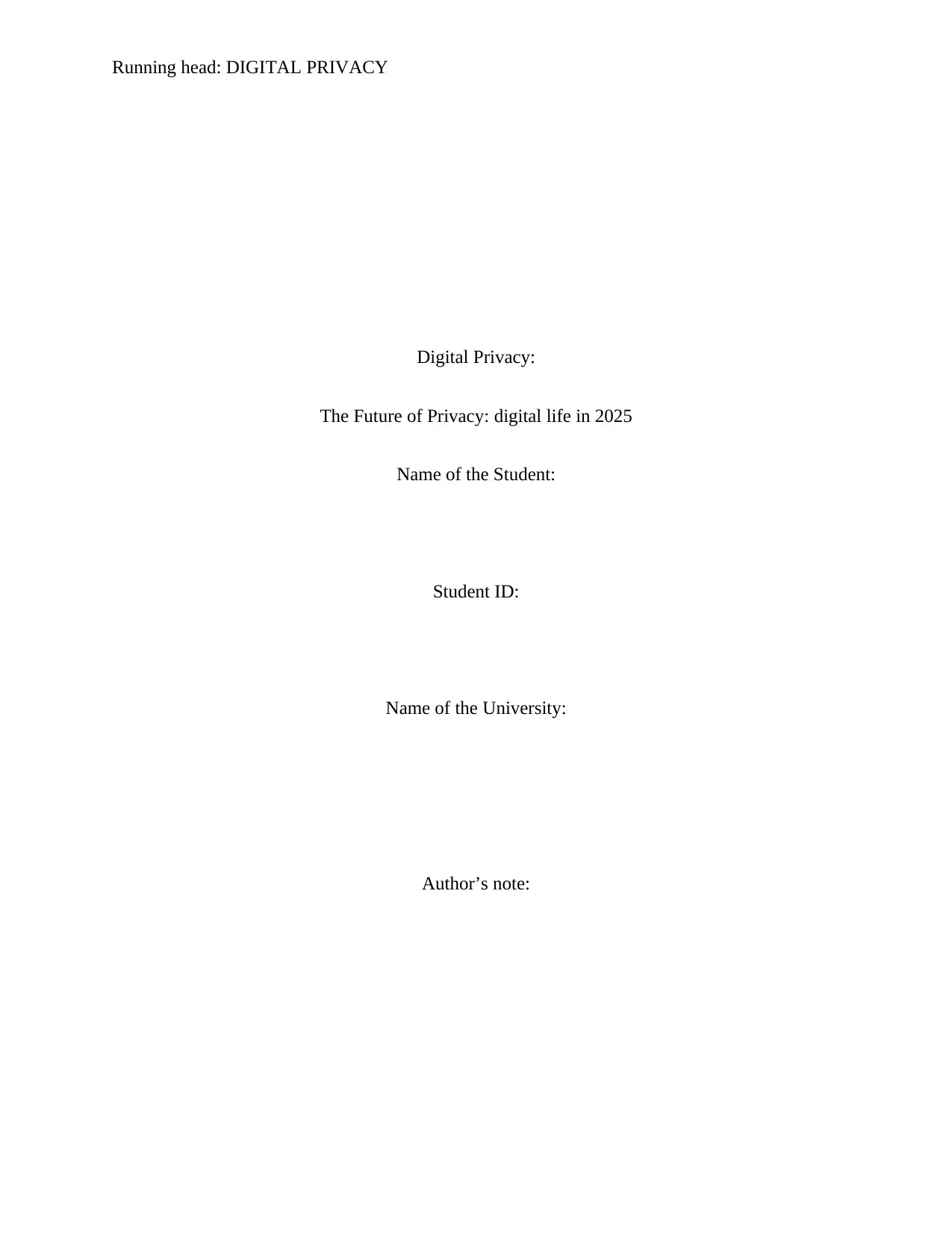
Running head: DIGITAL PRIVACY
Digital Privacy:
The Future of Privacy: digital life in 2025
Name of the Student:
Student ID:
Name of the University:
Author’s note:
Digital Privacy:
The Future of Privacy: digital life in 2025
Name of the Student:
Student ID:
Name of the University:
Author’s note:
Paraphrase This Document
Need a fresh take? Get an instant paraphrase of this document with our AI Paraphraser
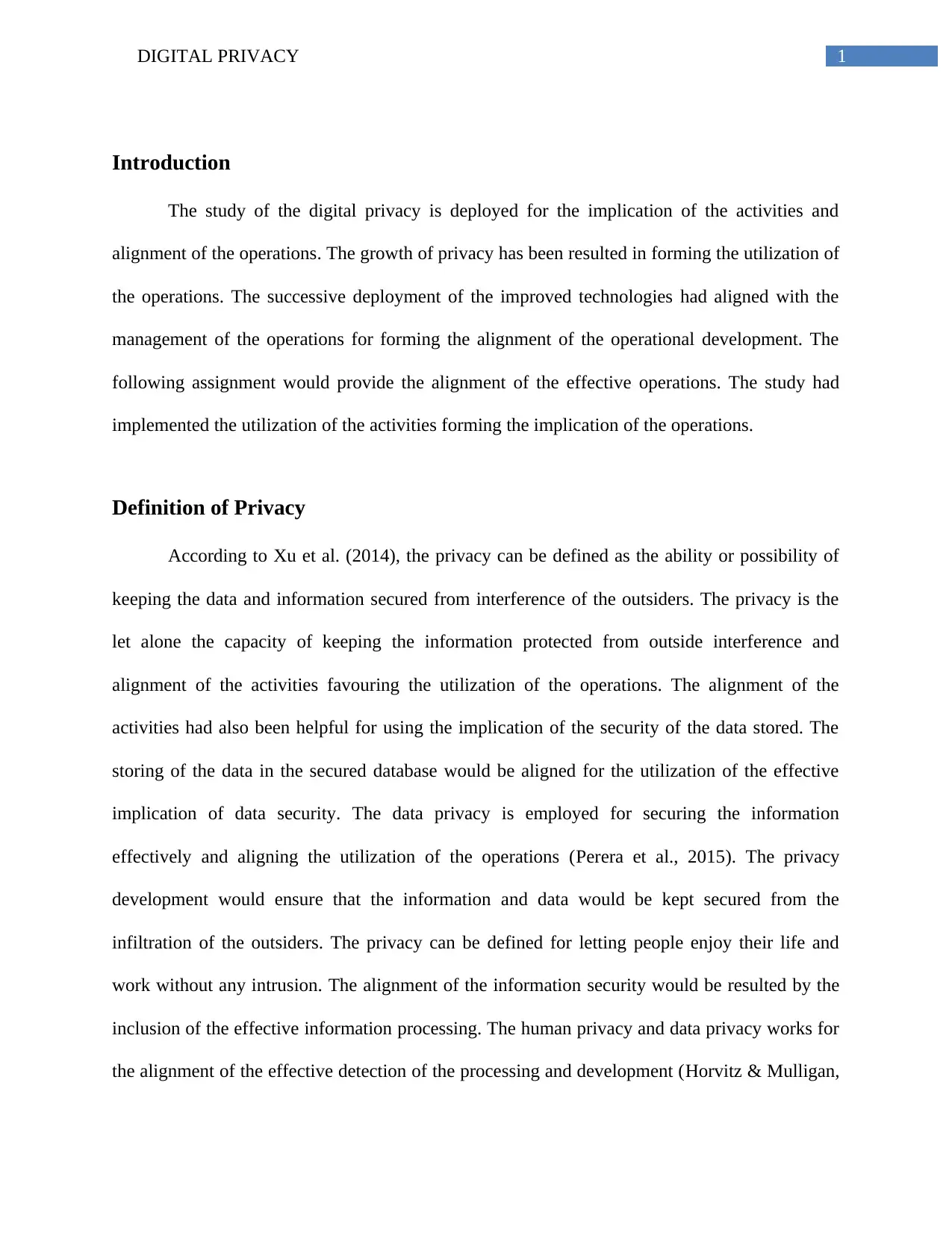
1DIGITAL PRIVACY
Introduction
The study of the digital privacy is deployed for the implication of the activities and
alignment of the operations. The growth of privacy has been resulted in forming the utilization of
the operations. The successive deployment of the improved technologies had aligned with the
management of the operations for forming the alignment of the operational development. The
following assignment would provide the alignment of the effective operations. The study had
implemented the utilization of the activities forming the implication of the operations.
Definition of Privacy
According to Xu et al. (2014), the privacy can be defined as the ability or possibility of
keeping the data and information secured from interference of the outsiders. The privacy is the
let alone the capacity of keeping the information protected from outside interference and
alignment of the activities favouring the utilization of the operations. The alignment of the
activities had also been helpful for using the implication of the security of the data stored. The
storing of the data in the secured database would be aligned for the utilization of the effective
implication of data security. The data privacy is employed for securing the information
effectively and aligning the utilization of the operations (Perera et al., 2015). The privacy
development would ensure that the information and data would be kept secured from the
infiltration of the outsiders. The privacy can be defined for letting people enjoy their life and
work without any intrusion. The alignment of the information security would be resulted by the
inclusion of the effective information processing. The human privacy and data privacy works for
the alignment of the effective detection of the processing and development (Horvitz & Mulligan,
Introduction
The study of the digital privacy is deployed for the implication of the activities and
alignment of the operations. The growth of privacy has been resulted in forming the utilization of
the operations. The successive deployment of the improved technologies had aligned with the
management of the operations for forming the alignment of the operational development. The
following assignment would provide the alignment of the effective operations. The study had
implemented the utilization of the activities forming the implication of the operations.
Definition of Privacy
According to Xu et al. (2014), the privacy can be defined as the ability or possibility of
keeping the data and information secured from interference of the outsiders. The privacy is the
let alone the capacity of keeping the information protected from outside interference and
alignment of the activities favouring the utilization of the operations. The alignment of the
activities had also been helpful for using the implication of the security of the data stored. The
storing of the data in the secured database would be aligned for the utilization of the effective
implication of data security. The data privacy is employed for securing the information
effectively and aligning the utilization of the operations (Perera et al., 2015). The privacy
development would ensure that the information and data would be kept secured from the
infiltration of the outsiders. The privacy can be defined for letting people enjoy their life and
work without any intrusion. The alignment of the information security would be resulted by the
inclusion of the effective information processing. The human privacy and data privacy works for
the alignment of the effective detection of the processing and development (Horvitz & Mulligan,
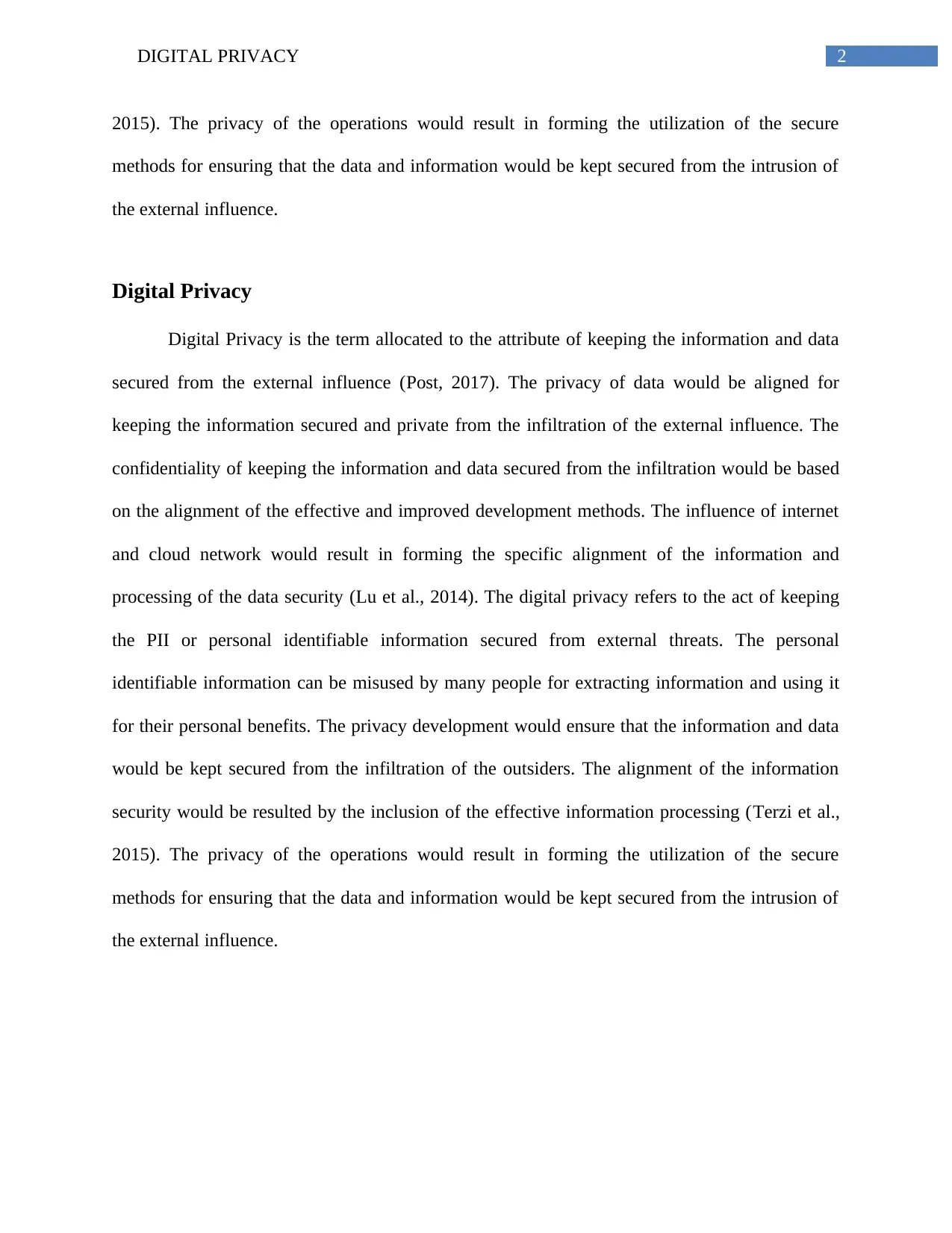
2DIGITAL PRIVACY
2015). The privacy of the operations would result in forming the utilization of the secure
methods for ensuring that the data and information would be kept secured from the intrusion of
the external influence.
Digital Privacy
Digital Privacy is the term allocated to the attribute of keeping the information and data
secured from the external influence (Post, 2017). The privacy of data would be aligned for
keeping the information secured and private from the infiltration of the external influence. The
confidentiality of keeping the information and data secured from the infiltration would be based
on the alignment of the effective and improved development methods. The influence of internet
and cloud network would result in forming the specific alignment of the information and
processing of the data security (Lu et al., 2014). The digital privacy refers to the act of keeping
the PII or personal identifiable information secured from external threats. The personal
identifiable information can be misused by many people for extracting information and using it
for their personal benefits. The privacy development would ensure that the information and data
would be kept secured from the infiltration of the outsiders. The alignment of the information
security would be resulted by the inclusion of the effective information processing (Terzi et al.,
2015). The privacy of the operations would result in forming the utilization of the secure
methods for ensuring that the data and information would be kept secured from the intrusion of
the external influence.
2015). The privacy of the operations would result in forming the utilization of the secure
methods for ensuring that the data and information would be kept secured from the intrusion of
the external influence.
Digital Privacy
Digital Privacy is the term allocated to the attribute of keeping the information and data
secured from the external influence (Post, 2017). The privacy of data would be aligned for
keeping the information secured and private from the infiltration of the external influence. The
confidentiality of keeping the information and data secured from the infiltration would be based
on the alignment of the effective and improved development methods. The influence of internet
and cloud network would result in forming the specific alignment of the information and
processing of the data security (Lu et al., 2014). The digital privacy refers to the act of keeping
the PII or personal identifiable information secured from external threats. The personal
identifiable information can be misused by many people for extracting information and using it
for their personal benefits. The privacy development would ensure that the information and data
would be kept secured from the infiltration of the outsiders. The alignment of the information
security would be resulted by the inclusion of the effective information processing (Terzi et al.,
2015). The privacy of the operations would result in forming the utilization of the secure
methods for ensuring that the data and information would be kept secured from the intrusion of
the external influence.
⊘ This is a preview!⊘
Do you want full access?
Subscribe today to unlock all pages.

Trusted by 1+ million students worldwide
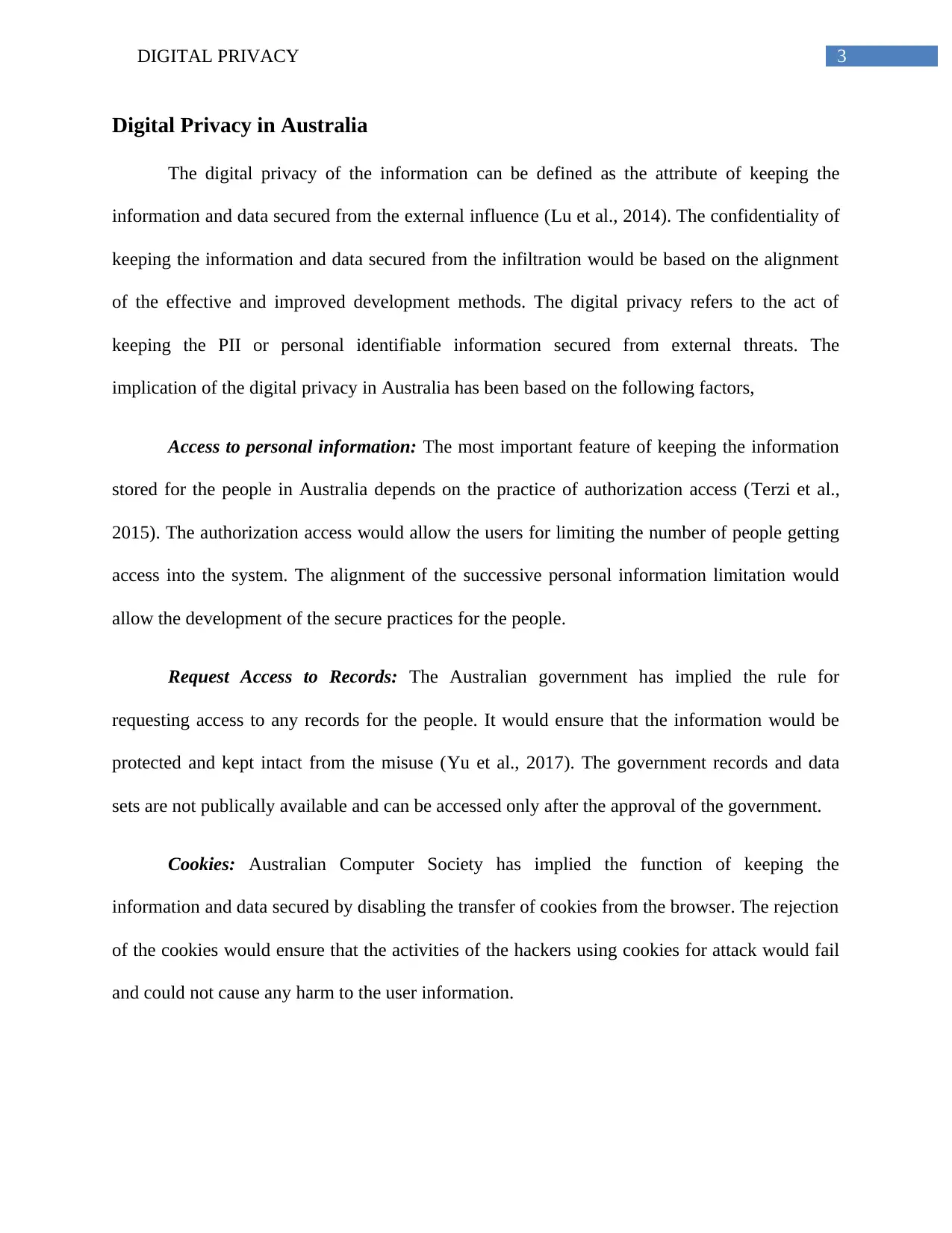
3DIGITAL PRIVACY
Digital Privacy in Australia
The digital privacy of the information can be defined as the attribute of keeping the
information and data secured from the external influence (Lu et al., 2014). The confidentiality of
keeping the information and data secured from the infiltration would be based on the alignment
of the effective and improved development methods. The digital privacy refers to the act of
keeping the PII or personal identifiable information secured from external threats. The
implication of the digital privacy in Australia has been based on the following factors,
Access to personal information: The most important feature of keeping the information
stored for the people in Australia depends on the practice of authorization access (Terzi et al.,
2015). The authorization access would allow the users for limiting the number of people getting
access into the system. The alignment of the successive personal information limitation would
allow the development of the secure practices for the people.
Request Access to Records: The Australian government has implied the rule for
requesting access to any records for the people. It would ensure that the information would be
protected and kept intact from the misuse (Yu et al., 2017). The government records and data
sets are not publically available and can be accessed only after the approval of the government.
Cookies: Australian Computer Society has implied the function of keeping the
information and data secured by disabling the transfer of cookies from the browser. The rejection
of the cookies would ensure that the activities of the hackers using cookies for attack would fail
and could not cause any harm to the user information.
Digital Privacy in Australia
The digital privacy of the information can be defined as the attribute of keeping the
information and data secured from the external influence (Lu et al., 2014). The confidentiality of
keeping the information and data secured from the infiltration would be based on the alignment
of the effective and improved development methods. The digital privacy refers to the act of
keeping the PII or personal identifiable information secured from external threats. The
implication of the digital privacy in Australia has been based on the following factors,
Access to personal information: The most important feature of keeping the information
stored for the people in Australia depends on the practice of authorization access (Terzi et al.,
2015). The authorization access would allow the users for limiting the number of people getting
access into the system. The alignment of the successive personal information limitation would
allow the development of the secure practices for the people.
Request Access to Records: The Australian government has implied the rule for
requesting access to any records for the people. It would ensure that the information would be
protected and kept intact from the misuse (Yu et al., 2017). The government records and data
sets are not publically available and can be accessed only after the approval of the government.
Cookies: Australian Computer Society has implied the function of keeping the
information and data secured by disabling the transfer of cookies from the browser. The rejection
of the cookies would ensure that the activities of the hackers using cookies for attack would fail
and could not cause any harm to the user information.
Paraphrase This Document
Need a fresh take? Get an instant paraphrase of this document with our AI Paraphraser
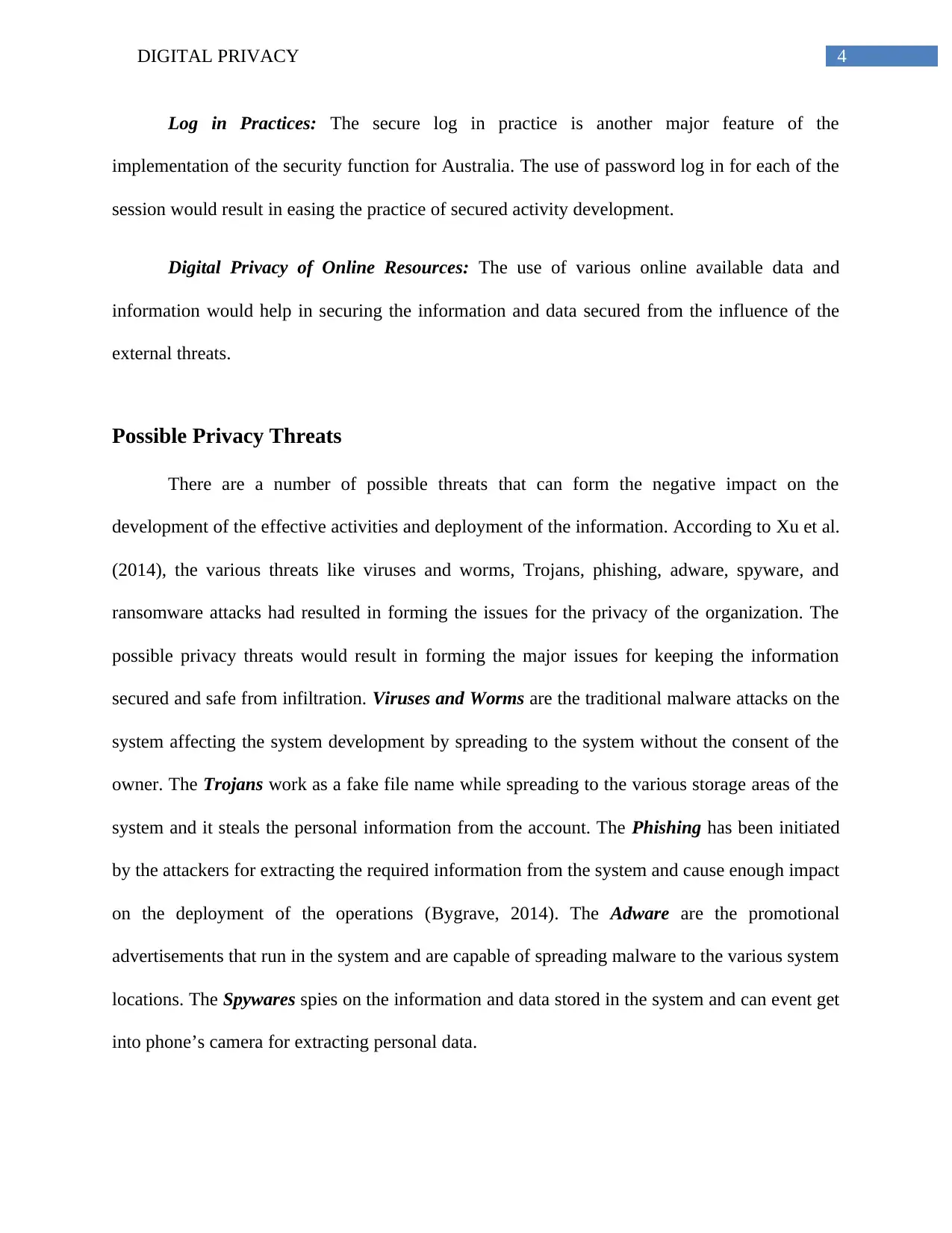
4DIGITAL PRIVACY
Log in Practices: The secure log in practice is another major feature of the
implementation of the security function for Australia. The use of password log in for each of the
session would result in easing the practice of secured activity development.
Digital Privacy of Online Resources: The use of various online available data and
information would help in securing the information and data secured from the influence of the
external threats.
Possible Privacy Threats
There are a number of possible threats that can form the negative impact on the
development of the effective activities and deployment of the information. According to Xu et al.
(2014), the various threats like viruses and worms, Trojans, phishing, adware, spyware, and
ransomware attacks had resulted in forming the issues for the privacy of the organization. The
possible privacy threats would result in forming the major issues for keeping the information
secured and safe from infiltration. Viruses and Worms are the traditional malware attacks on the
system affecting the system development by spreading to the system without the consent of the
owner. The Trojans work as a fake file name while spreading to the various storage areas of the
system and it steals the personal information from the account. The Phishing has been initiated
by the attackers for extracting the required information from the system and cause enough impact
on the deployment of the operations (Bygrave, 2014). The Adware are the promotional
advertisements that run in the system and are capable of spreading malware to the various system
locations. The Spywares spies on the information and data stored in the system and can event get
into phone’s camera for extracting personal data.
Log in Practices: The secure log in practice is another major feature of the
implementation of the security function for Australia. The use of password log in for each of the
session would result in easing the practice of secured activity development.
Digital Privacy of Online Resources: The use of various online available data and
information would help in securing the information and data secured from the influence of the
external threats.
Possible Privacy Threats
There are a number of possible threats that can form the negative impact on the
development of the effective activities and deployment of the information. According to Xu et al.
(2014), the various threats like viruses and worms, Trojans, phishing, adware, spyware, and
ransomware attacks had resulted in forming the issues for the privacy of the organization. The
possible privacy threats would result in forming the major issues for keeping the information
secured and safe from infiltration. Viruses and Worms are the traditional malware attacks on the
system affecting the system development by spreading to the system without the consent of the
owner. The Trojans work as a fake file name while spreading to the various storage areas of the
system and it steals the personal information from the account. The Phishing has been initiated
by the attackers for extracting the required information from the system and cause enough impact
on the deployment of the operations (Bygrave, 2014). The Adware are the promotional
advertisements that run in the system and are capable of spreading malware to the various system
locations. The Spywares spies on the information and data stored in the system and can event get
into phone’s camera for extracting personal data.
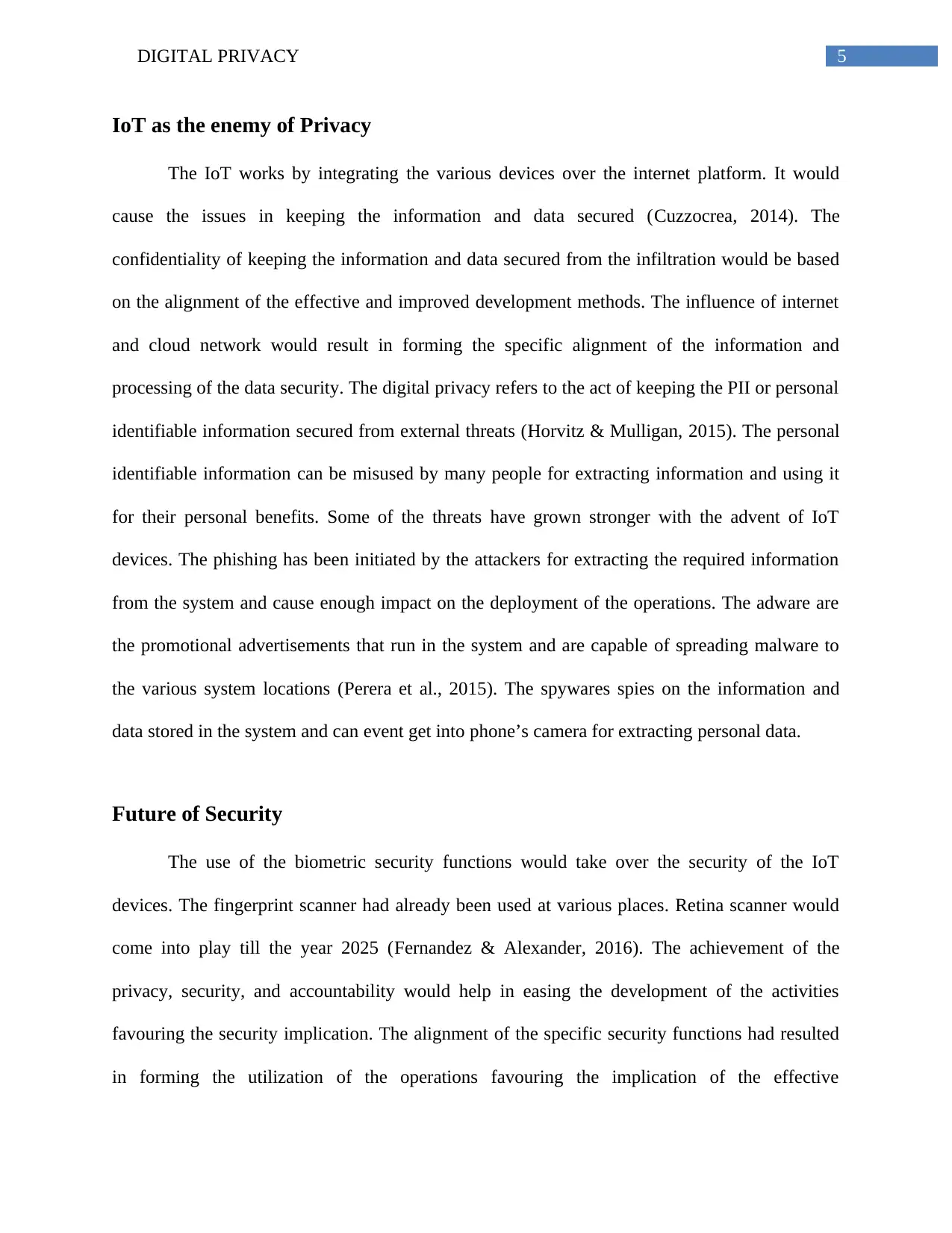
5DIGITAL PRIVACY
IoT as the enemy of Privacy
The IoT works by integrating the various devices over the internet platform. It would
cause the issues in keeping the information and data secured (Cuzzocrea, 2014). The
confidentiality of keeping the information and data secured from the infiltration would be based
on the alignment of the effective and improved development methods. The influence of internet
and cloud network would result in forming the specific alignment of the information and
processing of the data security. The digital privacy refers to the act of keeping the PII or personal
identifiable information secured from external threats (Horvitz & Mulligan, 2015). The personal
identifiable information can be misused by many people for extracting information and using it
for their personal benefits. Some of the threats have grown stronger with the advent of IoT
devices. The phishing has been initiated by the attackers for extracting the required information
from the system and cause enough impact on the deployment of the operations. The adware are
the promotional advertisements that run in the system and are capable of spreading malware to
the various system locations (Perera et al., 2015). The spywares spies on the information and
data stored in the system and can event get into phone’s camera for extracting personal data.
Future of Security
The use of the biometric security functions would take over the security of the IoT
devices. The fingerprint scanner had already been used at various places. Retina scanner would
come into play till the year 2025 (Fernandez & Alexander, 2016). The achievement of the
privacy, security, and accountability would help in easing the development of the activities
favouring the security implication. The alignment of the specific security functions had resulted
in forming the utilization of the operations favouring the implication of the effective
IoT as the enemy of Privacy
The IoT works by integrating the various devices over the internet platform. It would
cause the issues in keeping the information and data secured (Cuzzocrea, 2014). The
confidentiality of keeping the information and data secured from the infiltration would be based
on the alignment of the effective and improved development methods. The influence of internet
and cloud network would result in forming the specific alignment of the information and
processing of the data security. The digital privacy refers to the act of keeping the PII or personal
identifiable information secured from external threats (Horvitz & Mulligan, 2015). The personal
identifiable information can be misused by many people for extracting information and using it
for their personal benefits. Some of the threats have grown stronger with the advent of IoT
devices. The phishing has been initiated by the attackers for extracting the required information
from the system and cause enough impact on the deployment of the operations. The adware are
the promotional advertisements that run in the system and are capable of spreading malware to
the various system locations (Perera et al., 2015). The spywares spies on the information and
data stored in the system and can event get into phone’s camera for extracting personal data.
Future of Security
The use of the biometric security functions would take over the security of the IoT
devices. The fingerprint scanner had already been used at various places. Retina scanner would
come into play till the year 2025 (Fernandez & Alexander, 2016). The achievement of the
privacy, security, and accountability would help in easing the development of the activities
favouring the security implication. The alignment of the specific security functions had resulted
in forming the utilization of the operations favouring the implication of the effective
⊘ This is a preview!⊘
Do you want full access?
Subscribe today to unlock all pages.

Trusted by 1+ million students worldwide
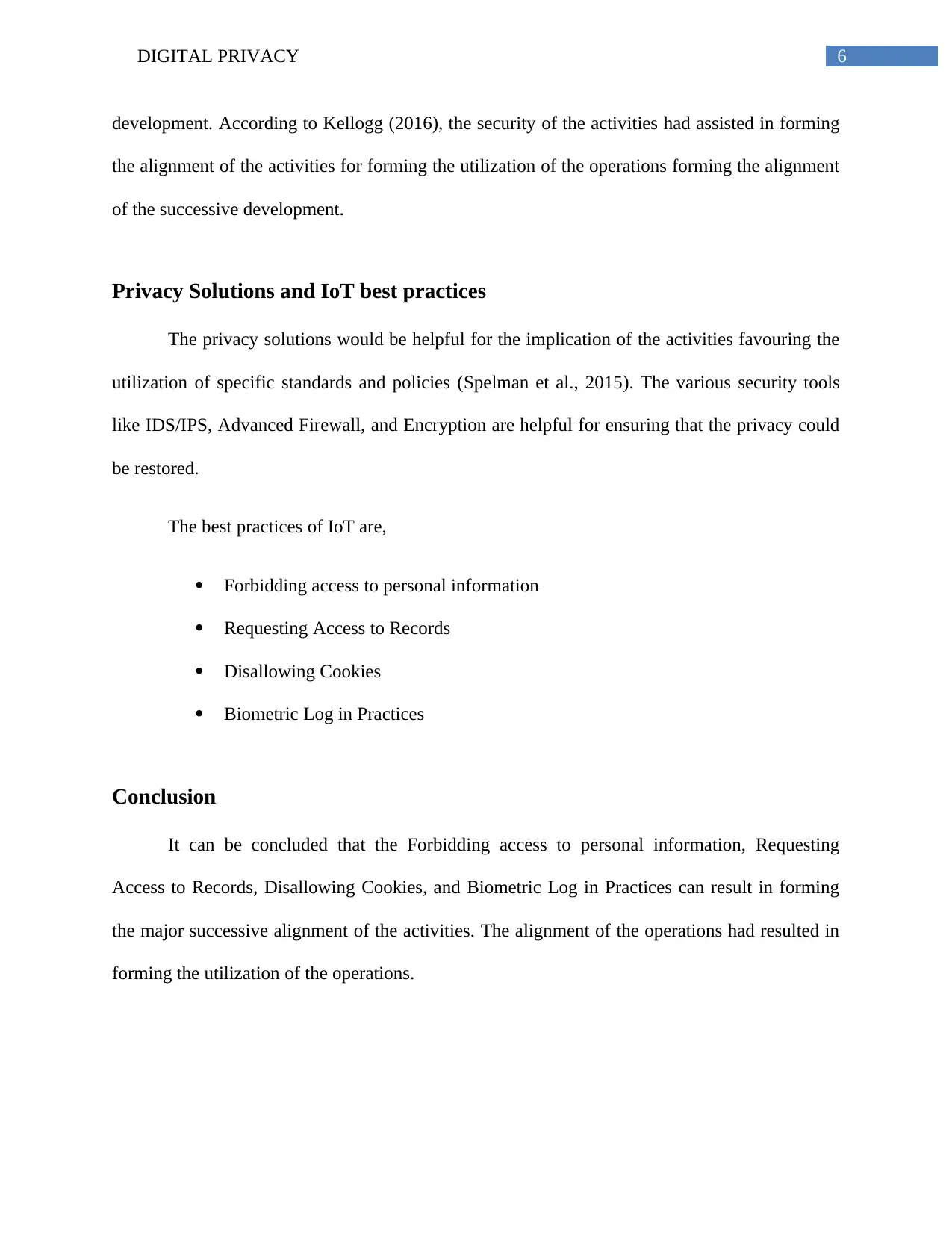
6DIGITAL PRIVACY
development. According to Kellogg (2016), the security of the activities had assisted in forming
the alignment of the activities for forming the utilization of the operations forming the alignment
of the successive development.
Privacy Solutions and IoT best practices
The privacy solutions would be helpful for the implication of the activities favouring the
utilization of specific standards and policies (Spelman et al., 2015). The various security tools
like IDS/IPS, Advanced Firewall, and Encryption are helpful for ensuring that the privacy could
be restored.
The best practices of IoT are,
Forbidding access to personal information
Requesting Access to Records
Disallowing Cookies
Biometric Log in Practices
Conclusion
It can be concluded that the Forbidding access to personal information, Requesting
Access to Records, Disallowing Cookies, and Biometric Log in Practices can result in forming
the major successive alignment of the activities. The alignment of the operations had resulted in
forming the utilization of the operations.
development. According to Kellogg (2016), the security of the activities had assisted in forming
the alignment of the activities for forming the utilization of the operations forming the alignment
of the successive development.
Privacy Solutions and IoT best practices
The privacy solutions would be helpful for the implication of the activities favouring the
utilization of specific standards and policies (Spelman et al., 2015). The various security tools
like IDS/IPS, Advanced Firewall, and Encryption are helpful for ensuring that the privacy could
be restored.
The best practices of IoT are,
Forbidding access to personal information
Requesting Access to Records
Disallowing Cookies
Biometric Log in Practices
Conclusion
It can be concluded that the Forbidding access to personal information, Requesting
Access to Records, Disallowing Cookies, and Biometric Log in Practices can result in forming
the major successive alignment of the activities. The alignment of the operations had resulted in
forming the utilization of the operations.
Paraphrase This Document
Need a fresh take? Get an instant paraphrase of this document with our AI Paraphraser
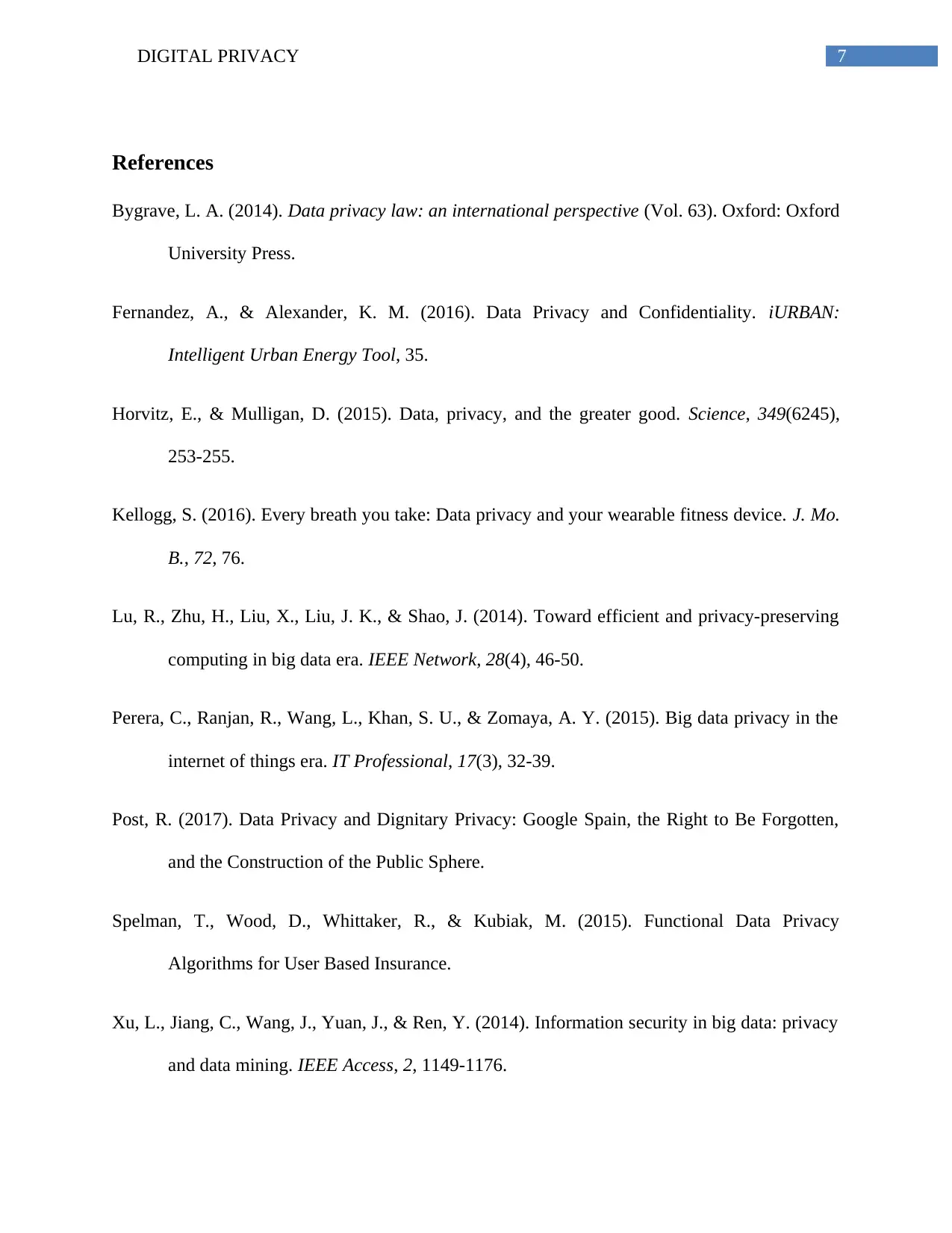
7DIGITAL PRIVACY
References
Bygrave, L. A. (2014). Data privacy law: an international perspective (Vol. 63). Oxford: Oxford
University Press.
Fernandez, A., & Alexander, K. M. (2016). Data Privacy and Confidentiality. iURBAN:
Intelligent Urban Energy Tool, 35.
Horvitz, E., & Mulligan, D. (2015). Data, privacy, and the greater good. Science, 349(6245),
253-255.
Kellogg, S. (2016). Every breath you take: Data privacy and your wearable fitness device. J. Mo.
B., 72, 76.
Lu, R., Zhu, H., Liu, X., Liu, J. K., & Shao, J. (2014). Toward efficient and privacy-preserving
computing in big data era. IEEE Network, 28(4), 46-50.
Perera, C., Ranjan, R., Wang, L., Khan, S. U., & Zomaya, A. Y. (2015). Big data privacy in the
internet of things era. IT Professional, 17(3), 32-39.
Post, R. (2017). Data Privacy and Dignitary Privacy: Google Spain, the Right to Be Forgotten,
and the Construction of the Public Sphere.
Spelman, T., Wood, D., Whittaker, R., & Kubiak, M. (2015). Functional Data Privacy
Algorithms for User Based Insurance.
Xu, L., Jiang, C., Wang, J., Yuan, J., & Ren, Y. (2014). Information security in big data: privacy
and data mining. IEEE Access, 2, 1149-1176.
References
Bygrave, L. A. (2014). Data privacy law: an international perspective (Vol. 63). Oxford: Oxford
University Press.
Fernandez, A., & Alexander, K. M. (2016). Data Privacy and Confidentiality. iURBAN:
Intelligent Urban Energy Tool, 35.
Horvitz, E., & Mulligan, D. (2015). Data, privacy, and the greater good. Science, 349(6245),
253-255.
Kellogg, S. (2016). Every breath you take: Data privacy and your wearable fitness device. J. Mo.
B., 72, 76.
Lu, R., Zhu, H., Liu, X., Liu, J. K., & Shao, J. (2014). Toward efficient and privacy-preserving
computing in big data era. IEEE Network, 28(4), 46-50.
Perera, C., Ranjan, R., Wang, L., Khan, S. U., & Zomaya, A. Y. (2015). Big data privacy in the
internet of things era. IT Professional, 17(3), 32-39.
Post, R. (2017). Data Privacy and Dignitary Privacy: Google Spain, the Right to Be Forgotten,
and the Construction of the Public Sphere.
Spelman, T., Wood, D., Whittaker, R., & Kubiak, M. (2015). Functional Data Privacy
Algorithms for User Based Insurance.
Xu, L., Jiang, C., Wang, J., Yuan, J., & Ren, Y. (2014). Information security in big data: privacy
and data mining. IEEE Access, 2, 1149-1176.
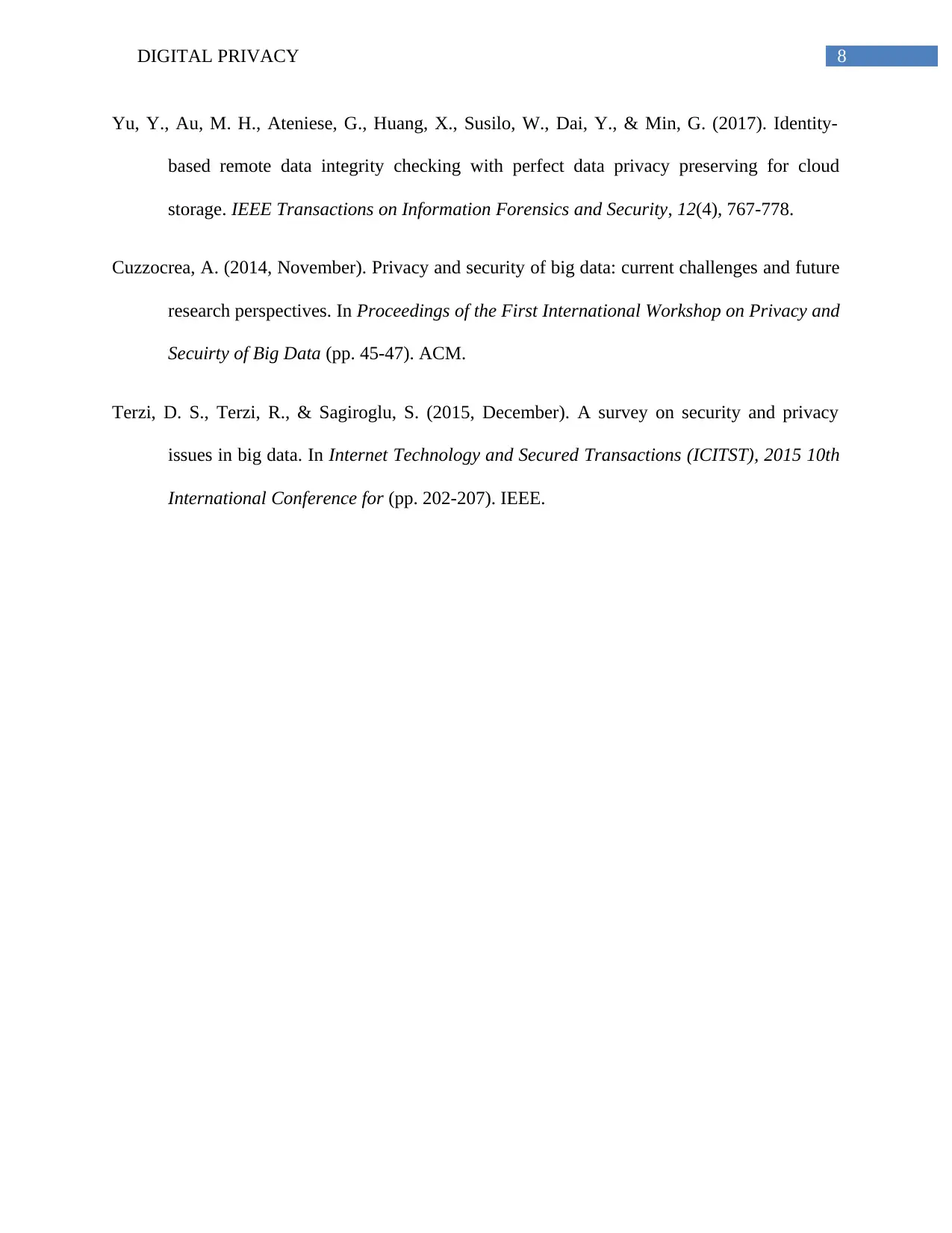
8DIGITAL PRIVACY
Yu, Y., Au, M. H., Ateniese, G., Huang, X., Susilo, W., Dai, Y., & Min, G. (2017). Identity-
based remote data integrity checking with perfect data privacy preserving for cloud
storage. IEEE Transactions on Information Forensics and Security, 12(4), 767-778.
Cuzzocrea, A. (2014, November). Privacy and security of big data: current challenges and future
research perspectives. In Proceedings of the First International Workshop on Privacy and
Secuirty of Big Data (pp. 45-47). ACM.
Terzi, D. S., Terzi, R., & Sagiroglu, S. (2015, December). A survey on security and privacy
issues in big data. In Internet Technology and Secured Transactions (ICITST), 2015 10th
International Conference for (pp. 202-207). IEEE.
Yu, Y., Au, M. H., Ateniese, G., Huang, X., Susilo, W., Dai, Y., & Min, G. (2017). Identity-
based remote data integrity checking with perfect data privacy preserving for cloud
storage. IEEE Transactions on Information Forensics and Security, 12(4), 767-778.
Cuzzocrea, A. (2014, November). Privacy and security of big data: current challenges and future
research perspectives. In Proceedings of the First International Workshop on Privacy and
Secuirty of Big Data (pp. 45-47). ACM.
Terzi, D. S., Terzi, R., & Sagiroglu, S. (2015, December). A survey on security and privacy
issues in big data. In Internet Technology and Secured Transactions (ICITST), 2015 10th
International Conference for (pp. 202-207). IEEE.
⊘ This is a preview!⊘
Do you want full access?
Subscribe today to unlock all pages.

Trusted by 1+ million students worldwide
1 out of 9
Related Documents
Your All-in-One AI-Powered Toolkit for Academic Success.
+13062052269
info@desklib.com
Available 24*7 on WhatsApp / Email
![[object Object]](/_next/static/media/star-bottom.7253800d.svg)
Unlock your academic potential
Copyright © 2020–2025 A2Z Services. All Rights Reserved. Developed and managed by ZUCOL.





